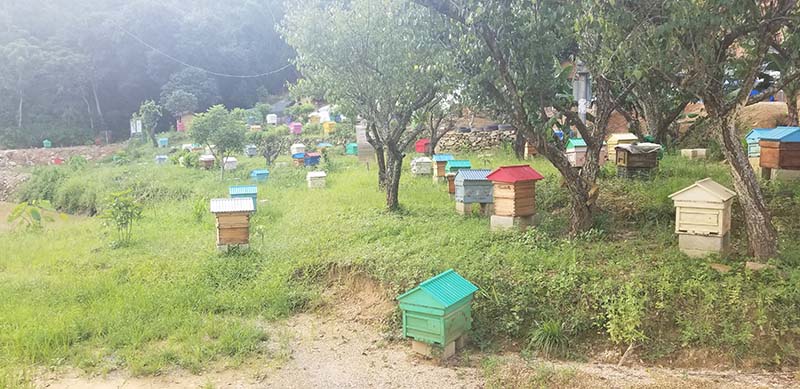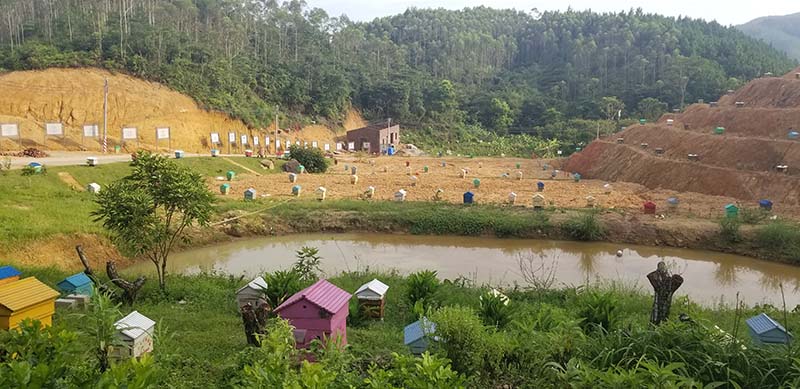What are the summer management methods for bees?
 Jul 26,2022
Jul 26,2022

 Lucia Ma
Lucia Ma
What are the summer management methods for bees?
Summer is the main season for beekeeping production, and the flowering period is one after the other, which is easy to cause the decline of the colony. The honey source lasts for 2 to 3 months, which can easily cause the queen bee to stop laying eggs; the third is the damage of wasps and pesticide poisoning, which can easily cause the bee colony to be extremely weakened. In order to make bees spend the hot summer safely, the following work should be done. What are the summer management methods for bees? What are the measures to cool the bee colony during the high temperature period? Learn more about it below.

Summer management of bees
1. Venue selection In summer, the colony should be placed in the shade of a ventilated tree, close to a place with clean water. Set up a box frame with a height of 50-80 cm to prevent rainwater from invading the nest. Mirex, etc. can be sprinkled on the side of the box frame to prevent ants from attacking.
2. Replace the queen bee In order to prevent the queen bee from aging and affecting egg laying, from April to May every year, more than 80% of the queen bee colony should be replaced with the new queen bee bred in that year.
3. Keep enough feed In addition to keeping 2-3 frames of honey spleens and one frame of pollen spleens in each colony, 2-3 frames of capped honey spleens and 1-2 frames of pollen spleens should also be reserved in each colony, so as to supply the bee colonies that are short of feed at any time.
4. Reward feeding Due to the lack of nectar sources in summer, the queen bee lays eggs. The excess honey spleen should be extracted in time, and reward feeding should be carried out in time.

5. Anti-starvation It mainly occurs in places where there is no nectar source, or after picking a nectar source and the second nectar source plant has started for a period of time, pay attention to feeding syrup and feeding pollen.
6. Prevent pesticide poisoning Due to the application of toxic pesticides in summer honey sources such as cotton, bees have suffered heavy casualties during collection. The colony of bees collecting cotton honey weakened rapidly, and some colonies were wiped out. Many bee farms are reluctant to enter the cotton area to release bees, which seriously affects the production of cotton and honey.
Ten measures to cool the bee colony during the high temperature period
The amount of cooling water should be added or subtracted according to the group potential, and the weak group should not be cooled excessively, so as to avoid the opposite effect. In case of continuous high temperature weather, the cooling water has been in the box for too long. When it is found that the water temperature and nest temperature do not change, new cold water should be replaced immediately, otherwise there will be no cooling effect. When the outside temperature is basically normal, the cooling measures should be lifted. Although adopting this method to cool down increases the labor of beekeepers, it can have a certain effect on maintaining a strong colony and increasing the output of royal jelly and autumn honey.
1. Avoid direct sunlight on the nest door and box ring The location should be facing south, under a big tree or a ventilated and shady place in a bamboo forest. In particular, avoid direct sunlight on the nest door in the afternoon, and try to avoid long-term direct sunlight on the box ring near the nest. Adjustment method: If the nest door is exposed to direct sunlight, you can move the nest door a little bit to the original position. If the position of the beehive is not shaded, you can move forward to the target direction set by the beehive about half a meter every day (no more than Half a meter), and then move it when it gets dark. Move it every day. When moving, it should be flat, and the landing should be flat, steady and light until it reaches the target position.
2. Use natural vine crops to shade Vines have the effect of heat-absorbing and shading. They can be close to the vines to block the direct sunlight on the beehive. The vines release water through transpiration to adjust the temperature and humidity. The experience results. In such an environment, the bee colony develops. Strong and vigorous, the disadvantage is that insect pests such as ants and cockroaches are easy to run into the box. Pay attention to applying quicklime or special drugs for biological preparations to eliminate insect pests from the source. Adjustment method: First, move a little bit every day, and move it under the vine plants. If not, you can plant vine plants, such as pumpkin, loofah, gourd, etc., before the high temperature season. Another can build a frame, put straw curtains or fir bark.

3. Heat insulation with PVC insulation material If there are no trees and shading plants in the open space, reflective film or foam board can be used to cover the beehive, and a sunshade net can be used.
4. Multiple water supply devices around the bee farm If you use buckets and other containers, it is best to put some floating objects in them, such as sponges, hay straws, etc. The bees can cool down by collecting water to the hive. You can put some salt in the ratio of one thousandth. Since ancient times, table salt has the effect of disinfection, and the sodium in table salt is an essential nutrient element for the growth and development of bees, so as to reduce the probability of bees going to the dung pits and stinky ditch to collect salt, thus helping to ensure the health of the bee colony.
5. Adjust the temperature through hygroscopic products Use sponge or pure cotton cloth with good hygroscopicity and place it on the auxiliary cover. This allows the temperature inside the hive to be regulated by absorbing or evaporating water molecules.
6. Expand the hive and widen the bee road at the right time If the box is too narrow, the colony has reached the entire nest box, the nest frame is full of recreational bees, and there are many bees resting at the door of the nest. method to make room to expand the hive and facilitate the ventilation inside the hive. If there are more bees than the spleen, the excess bees can be dispersed by adding an empty nest frame.
7. In the morning, noon and evening, the ground of the bee farm is watered and wet By reducing the outside temperature of the hive, the hot air in the hive can flow out, so as to achieve the purpose of reducing the temperature in the hive. If there is running water, a long pipe can be pulled and watered around the hive once a day in the morning, noon and evening to keep the ground on the ground. Wet, lower ground temperature. If there is no running water near the water source, you can pick up some water. If you really don’t want to carry water, you can dig a big hole and put some film on it and cover it. The water in rainy days can be stored later so that it can be used when the weather is dry.
8. Improve the heat dissipation device of the beehive itself The movable heat dissipation window can be opened, and the beehive air window can be opened at night to make the air convection inside and outside the box and reduce the stuffy heat.
9. Use wall trees and mountains for shade In high temperature seasons, bee colonies can be placed under tall broad-leaved trees, or under a pergola, or beside a shady mountain, or beside a wall to minimize the time of sunlight exposure.
10. Use ice packs to cool down in the box




 Tel:
Tel:

 Home
Home How do beehives attract bees?
How do beehives attract bees?  You May Also Like
You May Also Like







 Tel
Tel
 Email
Email
 Address
Address







